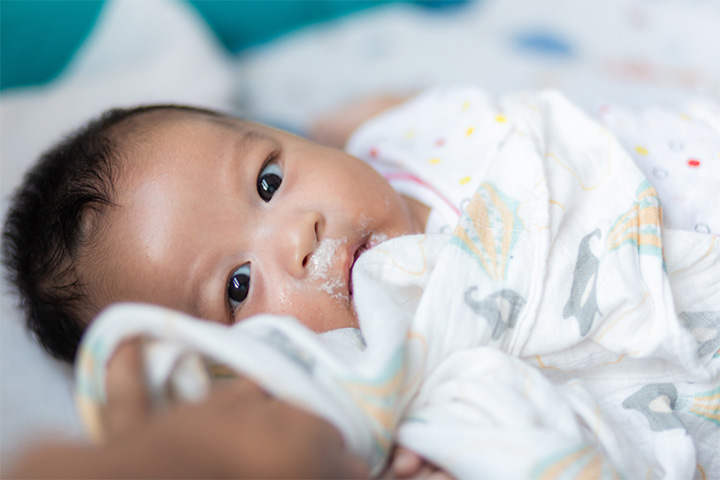Arch Backwards and Cries Excessively With Feeds

Image: Shutterstock
Baby arching back is frequently interpreted as a symptom of discomfort or pain caused by an external or internal cause. Crying, turning the head, or sleeping are frequently associated with an arched back in babies. It could be a symptom of a minor ailment or a more serious medical condition.
This post discusses various reasons your baby is arching their back and what you can do about it.
What Is Baby Arching?
Your baby could arch backward on his lower back and throw his hands in the air. He would extend his neck back as far as he can. This is dangerous because he could slip from you arms and hurt himself.
Image: iStock
In many cases, the baby may not arch his back until the sixth month. By nine months, he will be able to arch his back to express his discomfort, displeasure or other emotions.
Arching of the back can be a normal body language, but in some cases, it can be a symptom of some type of discomfort, indigestion delayed physical and mental development (1).
But why do babies position themselves backward? Wouldn't that hurt them?
Why Do Babies Arch Their Backs?
From mere fatigue to pain, arching backs in babies can mean a lot of things. Let's first know the harmless reasons for baby arching:
1. Expressing emotions:
Babies cannot speak, but it does not mean that they cannot communicate. Arching their back is one of the ways they express their frustration, anger, pain or such emotions. Just like adults, they could be upset for many reasons such as a change in their feeding bottle, a wet diaper or a boring toy.
2. Tiredness:
Your baby can be tired after a breastfeeding session or hungry after playtime. He might find arching of his back a convenient way to communicate with you. If you want to avoid such instances, look for other less aggressive cues and act accordingly.
While these are only temporary aberrations, baby arching can also reflect something more serious or a health condition.
3. Arching back after feeding – Gastroesophageal reflux:
If your baby is arching back when feeding, then it could be due to gastroesophageal reflux, also called acid reflux. Acid reflux is a condition in which the contents of the stomach move upwards through the lower esophageal sphincter and enter the esophagus due to weak stomach muscles.
The lower esophageal sphincter is a bundle of muscles located at the esophagus-stomach meeting point. It works like a valve restricting the reverse flow of acid and food from the stomach into the food pipe. In babies, this valve is underdeveloped and leads to the movement of the stomach contents towards the food pipe. GERD (gastro oesophageal reflux) is quite common in infants and the baby vomits out the milk.
Image: Shutterstock
Your baby could arch back and vomit as a natural reaction to the reflux (2). It can also be accompanied by a cough, irritability during feeding and frequent regurgitation. Arching may also indicate silent reflux, wherein the baby will not vomit but still have reflux. If you notice such symptoms, consult a pediatrician. One of the common reasons for arching of the back is colic. Colic occurs secondary to gases in the stomach, and gaseous discomfort can lead the baby to cry. Arching of the back stretches the stomach and causes relief in stomach pain. Colic starts by 4 week of age and goes away by 3 months of age.
The reflux has to be treated to prevent the arching of the back.
- Keep the baby upright after feeding as gravity will help pull the food down naturally and mitigate the chance of regurgitation.
- Give frequent but small feeds rather than topping his tummy in one go. This will prevent the stomach from filling to the brim.
- Do not put the baby to sleep immediately after a feed. Instead, carry the baby for some time and have a stroll. Baby arching back and crying at night are noted in babies who are fed just before going to bed.
- Do not make your baby wear tight clothing as it may put external pressure on the lower esophageal sphincter.
4. Baby arching while crying due to jaundice — Kernicterus:
If the baby arches back and cries when he is suffering from jaundice or other liver ailments, he may be showing signs of kernicterus, a bilirubin-induced damage to the brain. Jaundice results in excessive production of bilirubin. In extreme situations, bilirubin may breach the blood-brain barrier and damage parts of the brain, causing involuntary motor spasms (3). Kernicterus can lead to brain damage, mental retardation and seizures. This condition should be immediately notified to the doctor.
5. Baby sleeps with head arched back — Obstructive sleep apnea:
Sometimes, the baby arches back when sleeping or resting on his back. If you adjust his position, he will slip back to the arched position or violently wake-up and start crying. Such instances can indicate obstructive sleep apnea, a chronic obstruction of the upper respiratory system. The baby will try to alleviate the pressure on the upper respiratory tract by positioning his head in an arched form (4). This helps in smoother airflow in the lungs, and the baby will try to hold this position involuntarily during sleep.
Sleep apnea predominantly occurs during deep sleep but can also happen when the baby is lying down flat in a state of drowsiness.
The condition can be treated through medication or surgery.
6. Arching back while sitting — Nerve injury:
Image: iStock
The baby arches back when sitting or when he is tired if he has a nerve injury caused by premature birth or after birth. Nerves of the baby could be damaged due to physical pressure during difficult deliveries. During a difficult delivery, nerves around the shoulder may be damaged, leading to Erb's Palsy. Shooting pain down the shoulder and the back can cause arching of the back.
Sometimes, you may see the baby arching his back during teething due to the nerve irritation caused within gums. Often, this pain radiates to other parts of the head causing the baby to arch his back as a reflex.
Baby arching back due to neurological disorders:
Baby arching his back could be a symptom of a neurological problem. Following are some disorders that could be indicated by an arching back in the baby.
7. Cerebral palsy:
When the baby arches the back in this condition, he does it involuntarily and has no control on it. If the baby stretches a lot and arches back too often without any control, then it is quite likely to be an early symptom of cerebral palsy. Cerebral palsy is caused by damage to the brain generally by hypoxia during birth. It leads to delayed motor and mental development and seizures.
Cerebral palsy refers to a range of muscular movement disorders caused by damage to the part of the brain that controls motor movements. Look out for these back arching movements that could indicate cerebral palsy:
- Tonic labyrinthine reflex: You will see baby arching back and stiffening legs during the first few months, and this is referred to as tonic labyrinthine reflex (5).
- Asymmetrical tonic reflex: This is exhibited by baby arching back and turning his head. The legs usually extend to the side in which the head is turned (6).
There is, unfortunately, no cure for cerebral palsy. However, you can ensure a normal upbringing for your child through numerous physical and mental therapy programs.
8. Autism:
Autism is a genetic ailment causes stunted neurological development. Autism does not necessarily mean that the child has flawed cognitive abilities, but he could have distinct behavior. One of the early signs of autism is certain physical gestures such as arching the back when held or sleeping on the side with head arched back (7). Since autistic individuals have trouble developing sound social relations, a baby with autism arches back when upset, to avoid physical contact with the person holding him, even if it is a parent.
However, arching the back does not mean that your baby has autism. It may just be one of the signs of autism. You need to collate several other critical symptoms of autism the baby displays in the first two years.
Baby arching back due to developmental delay:
A baby stiffening body and arching back repeatedly could be a symptom of other neurological issues that cause physical and mental developmental delays.
9. Asperger syndrome:
Image: iStock
Asperger syndrome is characterized by difficulties in developing social bonds and having nonverbal communication through eye contact or facial gestures. It is very similar to autism in its prognosis but less severe (8).
Asperger syndrome is considered a part of the autistic spectrum disorder and therefore arching back could be one of the symptoms.
10. Infantile spasms:
If you observe stiffening of body and arching of back in the form of a convulsion without any other symptoms of autistic spectrum disorder, then it is quite likely the baby is going through an infantile spasm. It is called epileptic seizure and is a type of ailment in the nervous system that causes the baby to have an involuntary contraction of muscles that cause arching back and neck.
For serious health conditions, take your baby to the doctor immediately after you suspect that something is amiss. But if the baby is arching back for less-serious reasons, you may make an effort to discourage him.
What To Do When The Baby Is Arching Their Back?
Be it a normal or a serious condition, you may follow the below tips to help your baby. But, the first thing to do is to stop worrying.
- Calm down your baby: Take your baby into a quieter room with enough lighting. This can be soothing for babies suffering from autistic spectrum disorders.
- Cuddle your baby: Place your little one close to your chest in a comfortable, straight position. A warm cuddle with the mother can be quite comforting to the baby, calming him down. Try to relax the baby.
- Divert the baby's attention: It is an age old trick to calm down babies and should work great for babies that arch their backs because of restlessness or irritation.
Image: iStock
- Use comfortable clothing: Sometimes, your baby could arch due to the irritation caused by fabric or a tag in the cloth. Use comfortable fabrics for the child, in accordance with the season and temperature.
- Put the baby on a different surface: If the baby has a tendency to arch only on a certain kind of mattress or bed, then replace it with a more comfortable one.
A baby arching back is usually not a sign of ailment but an expression of irritability, fatigue, or discomfort by the baby. Try calming your baby by cuddling or diverting their attention. If you observe recurring arching of the back, it may indicate some underlying conditions such as acid reflux, jaundice, or sleep apnea. Check for accompanying symptoms that may be early manifestations of nerve problems or conditions such as autism, cerebral palsy, or infantile spasms. Consult a pediatrician if the condition seems worrisome or worsens gradually.
References:
MomJunction's articles are written after analyzing the research works of expert authors and institutions. Our references consist of resources established by authorities in their respective fields. You can learn more about the authenticity of the information we present in our editorial policy.
- Arched Back Crying Baby.
https://www.birthinjuryhelpcenter.org/baby-crying-arched-back.html - What is baby reflux? Symptoms and support.
https://www.nct.org.uk/baby-toddler/feeding/common-concerns/what-baby-reflux-symptoms-and-support - Birth Injury Symptoms.
https://www.birthinjuryguide.org/additional-resources/birth-injury-symptoms/ - Obstructive Sleep Apnea.
https://www.chop.edu/conditions-diseases/obstructive-sleep-apnea - Signs and Symptoms of Cerebral Palsy.
https://www.cerebralpalsy.org/about-cerebral-palsy/sign-and-symptoms - Asymmetrical tonic neck reflex in children.
https://dr.lib.iastate.edu/entities/publication/64d6ecf1-322a-4e8d-8550-1cef61033f3a - Philip Teitelbaum et al.; (1998); Movement analysis in infancy may be useful for early diagnosis of autism.
https://www.ncbi.nlm.nih.gov/pmc/articles/PMC25000/ - Mental and behavioural disorders.
https://icd.who.int/browse10/2015/en#/F84.5
Was this article helpful?
The following two tabs change content below.
- Reviewer
- Author

Rohit Garoo did MBA from Osmania University and holds a certificate in Developmental Psychology from The University of Queensland. The zoologist-botanist turned writer-editor has over 8 years of experience in content writing, content marketing, and copywriting. He has also done an MBA in marketing and human resources and worked in the domains of market research and e-commerce. Rohit writes topics... more

Dr. Mubina Agboatwalla is a well-known pediatrician, practicing paediatrics since the last 20 years in Karachi Pakistan. She is the head of the department of Pediatrics in Karachi Liaquat Hospital, as well as her private practice in three specialist clinics in Pediatrics. She is also a Public Health Specialist specializing in preventive health including nutrition, breastfeeding and infectious diseases especially... more
johnstonparse1947.blogspot.com
Source: https://www.momjunction.com/articles/baby-arching-back-ways-to-correct-it_00415121/





0 Response to "Arch Backwards and Cries Excessively With Feeds"
Post a Comment